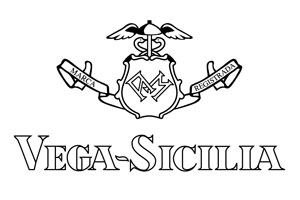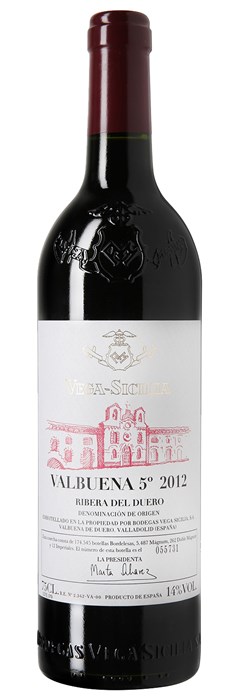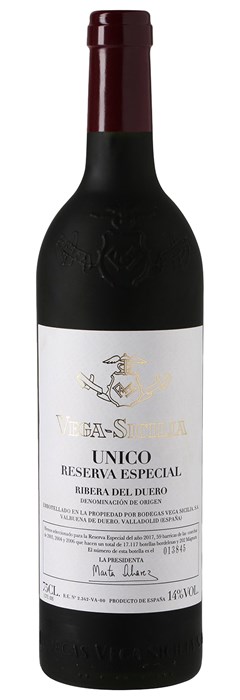Vega Sicilia
Vega Sicilia was founded in 1864, when Eloy Lecanda established a winery. He decided to experiment with the local grape variety, Tempranillo and the French varieties that he acquired in Bordeaux: 18,000 shoots of Cabernet Sauvignon, Malbec, Merlot and Pinot Noir. Right from the outset the winery spearheaded the winemaking industry and soon gained recognition as a symbol of the Golden Legend of Spanish red wine.
In 1903, the next proprietors of Vega Sicilia were the Herrero family. They appointed the oenologist Domingo Garramiola, who was the driving force behind the creation of two exceptional wines: Valbuena and Único. The earliest bottles were distributed among the aristocracy and selected members of the Bourgeoisie of the day, however never for commercial purposes. These were exclusive wines, which could not be bought with money - they could only be obtained through friendship or special connections.
The estate changed hands several more times before its acquisition in 1982 by the current owners, the Alvarez familly. They initially bought Vega Sicilia as an investment. Much had to be done before this venture could pay off though, including the restoration of the property and the vineyards, together with the checking and monitoring of the parcels of the older vines, always with special emphasis on the ageing time required to guarantee the unique character of Vega Sicilia, as called for by tradition.
As Pablo Álvarez put it just after the purchase, "Morally, we cannot live off the demand which comes from historic prestige without offering more.” Vega Sicilia is self-sufficient, using the grapes from its own vineyards and is based on the concept of a "terroir”: a place with its own, historically proven identity.
Under the management of Pablo Álvarez, the family has continued to make further investments in its winemaking business:
- in 1991 the Alión Winery was set up with 100 hectares of land (247 acres) in the Ribera del Duero region
- the Tokaj Oremus Winery in Hungary, with 120 hectares (296.5 acres) was acquired in 1993
- in 1997, the Pintia Winery, with 96 hectares (237 acres), was established in the Spanish region of Toro.
Their latest business venture started twelve years ago, when Benjamin de Rothschild and the Álvarez family decided to become associates and created a new winery in "La Rioja” intent on producing a wine that would live up to the expectations it would awaken.
Defined as a very Spanish wine, the character of Vega Sicilia is due not only to the top-quality grapes used and the painstaking perfectionism involved in its production, but above all, to the eye for detail that the Álvarez family has succeeded in enshrining in its wines.
Vineyards
The total vineyard area of about 200 hectares is distributed in 52 viticultural management plots, divided into 19 different soils, according to the taxonomical classification, with an average age of around 30 years. It should be stressed that all the grapes used to make the group's wines are from vines over 10 years old, the minimum required by the family.
The climate is continental with Atlantic influences. The mean annual temperature is about 10.5ºC, with annual rainfall of 500mm concentrated, especially, in spring and autumn. The annual sunshine comes to 2,200 hours, with abundant morning mist and fog, due to the proximity of the River Duero, and spring frosts that can last until the end of May. Winters are harsh, with temperatures falling below -15ºC (5°F), while in the hot, dry summers, thermometers can register over 40ºC (104°F), with marked differences between day and night, and occasional rain and hail storms.
Viticulture
Viticulture has been the backbone of most of the work carried out on the estate. Vega Sicilia now has a flourishing vineyard of 200 hectares (494 acres) of which 70% is dedicated to Único and Valbuena and the rest to Alión, with average yields of 2,500kg/ha. However, the ceiling of production potential is never reached, on the one hand because of the unpredictable weather of the Ribera, where there is always frost or hail, and on the other, because the company's quality parameters mean only the best grapes are used for these wines.
The vine replanting policy carried out in Vega Sicilia involves highly environment-friendly management. When the plot to be replanted has been dug up, it is allowed to rest for a period of 5 years, in which time crops with nematicide properties are sown and incorporated into the soil in order to improve its physical and chemical characteristics. No herbicides or chemical disinfectants are used and losses during the cultivation are replaced annually to ensure that the unit yield is homogeneous. The average age of vines is 30 years, although there are much older plots used for very specific functions, managed with extreme care and used in separate fermentations, or to obtain the estate's own vegetable matter.
The main feature of the estate's profile is the Duero, which has carved a way through the limestone and Miocenic marlstone of the moorland and, overflowing, left its mark in the form of terraces. These are varied, complex soils in which three sedimentary environments are overlaid: fluvial, colluvial and aeolian, in different geological stages, now materialized as quartzite gravel in the soil profile, limestone fragments on the moor, a deep soil, and pine woods on dunes, respectively. Soils that have been shown to be perfect for vine cultivation and which are capable of giving Vega Sicilia wines a different, unrepeatable character.
The varieties grown are Tempranillo, called Tinto Fino locally, which occupies about 85% of the vineyard, together with the French Cabernet Sauvignon and Merlot, and a residual amount of Malbec, which is used, in different proportions, in both the Valbuena and the "Único”.
The plant material comes from the estate and is the result of multiplication based on mass selection of the best plants. This selection is carried out according to empirical and analytical quality parameters of the results observed in the wines and in their production. This historic selection of Vega Sicilia's own plant material is the basis of the clonal selection studies currently carried out.


























